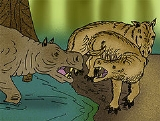
Elomeryx
Encyclopedia
Elomeryx is an extinct genus of artiodactyl ungulate
, and is among the earliest known anthracotheres. The genus was extremely widespread, first being found in Asia
in the middle Eocene
, in Europe
during the latest Eocene, and having spread to North America
by the early Oligocene
.
Elomeryx was about 1.5 metres (4.9 ft) in body length, and had a long, vaguely horse-like head. It small tusk
s which it used to uproot plant
s, and spoon
-shaped incisors ideal for pulling and cropping water plants. Elomeryx had five-toed hind legs and four-toed front legs, resulting in wide feet which made it easier to walk on soft mud. It probably had similar habits to the modern hippopotamus
, to which it may have been related.
Ungulate
Ungulates are several groups of mammals, most of which use the tips of their toes, usually hoofed, to sustain their whole body weight while moving. They make up several orders of mammals, of which six to eight survive...
, and is among the earliest known anthracotheres. The genus was extremely widespread, first being found in Asia
Asia
Asia is the world's largest and most populous continent, located primarily in the eastern and northern hemispheres. It covers 8.7% of the Earth's total surface area and with approximately 3.879 billion people, it hosts 60% of the world's current human population...
in the middle Eocene
Eocene
The Eocene Epoch, lasting from about 56 to 34 million years ago , is a major division of the geologic timescale and the second epoch of the Paleogene Period in the Cenozoic Era. The Eocene spans the time from the end of the Palaeocene Epoch to the beginning of the Oligocene Epoch. The start of the...
, in Europe
Europe
Europe is, by convention, one of the world's seven continents. Comprising the westernmost peninsula of Eurasia, Europe is generally 'divided' from Asia to its east by the watershed divides of the Ural and Caucasus Mountains, the Ural River, the Caspian and Black Seas, and the waterways connecting...
during the latest Eocene, and having spread to North America
North America
North America is a continent wholly within the Northern Hemisphere and almost wholly within the Western Hemisphere. It is also considered a northern subcontinent of the Americas...
by the early Oligocene
Oligocene
The Oligocene is a geologic epoch of the Paleogene Period and extends from about 34 million to 23 million years before the present . As with other older geologic periods, the rock beds that define the period are well identified but the exact dates of the start and end of the period are slightly...
.
Elomeryx was about 1.5 metres (4.9 ft) in body length, and had a long, vaguely horse-like head. It small tusk
Tusk
Tusks are elongated, continuously growing front teeth, usually but not always in pairs, that protrude well beyond the mouth of certain mammal species. They are most commonly canines, as with warthogs, wild boar, and walruses, or, in the case of elephants and narwhals, elongated incisors...
s which it used to uproot plant
Plant
Plants are living organisms belonging to the kingdom Plantae. Precise definitions of the kingdom vary, but as the term is used here, plants include familiar organisms such as trees, flowers, herbs, bushes, grasses, vines, ferns, mosses, and green algae. The group is also called green plants or...
s, and spoon
Spoon
A spoon is a utensil consisting of a small shallow bowl, oval or round, at the end of a handle. A type of cutlery , especially as part of a place setting, it is used primarily for serving. Spoons are also used in food preparation to measure, mix, stir and toss ingredients...
-shaped incisors ideal for pulling and cropping water plants. Elomeryx had five-toed hind legs and four-toed front legs, resulting in wide feet which made it easier to walk on soft mud. It probably had similar habits to the modern hippopotamus
Hippopotamus
The hippopotamus , or hippo, from the ancient Greek for "river horse" , is a large, mostly herbivorous mammal in sub-Saharan Africa, and one of only two extant species in the family Hippopotamidae After the elephant and rhinoceros, the hippopotamus is the third largest land mammal and the heaviest...
, to which it may have been related.

